Tips for Taking Kids to Get a Haircut

Scissors, clippers, and sitting still…oh my! Getting a haircut can be a challenging experience for children, especially when it is a new or unfamiliar place, space, or feels like sensory overload. Getting a haircut can be upsetting for many children and stressful for families. The most common worries or fears children have about getting a haircut are: “the feeling of the cape around their neck, getting their hair wet, the sounds of buzzers and hairdryers, and the feeling of a comb running through their hair.” (The Summit Center) Luckily, Child Inspired has tips to help support your child when getting a haircut.
But first… keep in mind that the earlier you expose your child to a routine or activity, the more accustomed they will become to it. Take your child for a haircut beginning at a young age. Getting into a habit of getting a haircut at the same salon or barber shop with the same hairdresser or barber will help familiarize your child with the location and staff, which in turn creates a more comfortable environment and experience. If your child is older and/or needs more than just repeated exposure, focus on the three preparation tips below to help make getting a haircut feel a little less overwhelming for your child.
Step 1: Provide Opportunity for Questions
Kids LOVE to ask questions! Odds are that your child probably has A LOT of questions before getting their haircut. Depending on your child’s age and/or abilities, their concerns may be difficult for your child to express verbally. Consider your child’s perspective and think about what you would want to know before going to a new place or participating in a new experience. It is important to provide “opportunity to talk through the experience of getting a haircut and what to expect.” (Kid Snips) Using the ideas below, you will be able to see what questions or worries your child has and address their concerns in a positive and proactive way.
- Take your child to the salon or barbershop ahead of time to see what the shop looks like.
- Show your child videos of people getting haircuts (using both scissors and clippers) or stop by the salon to watch people get their haircut.
- Play! Use pretend play to act out what getting a haircut will look like. Get out the dolls or stuffed animals and pretend to style and brush their hair. Consider letting your child be the stylist and let them brush your hair and and add in fun clips (just remember to do this on a day when you don’t have school drop off)! “They might want to pretend to cut and style your hair too.” (Kid Snips) Try making a day of it and play salon at home! Set up a kid- salon and pretend to cut your child’s hair and style it. This will make your child feel like this is a special experience and will peak their interest about getting a real haircut.
Step 2: Teach the Expectations for Getting a Haircut
There are a lot of new and “scary” sounds at the hair salon or barber shop (ie, scissors, hairdryer, etc). Set the expectations for what a haircut sounds and feels like. This will help your child feel safe. Demonstrate and talk through the feelings of the pull of the comb used to brush the knots out of your hair, the chill of the damp water running though your hair, the sound of the snap of the cape around your neck used to protect your clothes, the quick snip of the point on the scissors, and the buzzing sound of the clippers.
- Play a video of the sounds at the salon to familiarize children with the sounds and environment.
- Turn on a hair dryer or clippers to help normalize the sounds.
- Put on sheets as capes when brushing hair.
- Build up to using each tool to help desensitize. Start with looking at the tool (brush, spray bottle, scissors, electric clippers, hair dryer, etc.), then holding the tool (if age appropriate), and then moving the tool (brush, spray bottle, hair dryer) around your head (with scissors or electric clippers pretend to cut the hair by using the sound to represent the act moving it above, around, and behind the hair).
- Include your child by having them practice brushing their hair or spraying their hair with water or detangler.
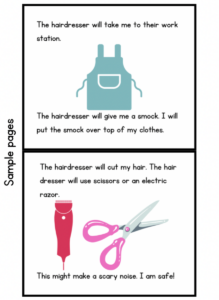 Child Inspired has two simple tools to help children prepare for getting a haircut. The first, is the Haircut Social Story. Child Inspired’s Haircut Social Story is a customized social story for your child specific to their social needs or a targeted behavior at the hair salon or barber shop. Stories are told in the ‘first person’ with your child as the main character. These simple stories describe your child in a social situation (getting a haircut) and walk children through expectations and process. Each book comes with laminated pages for durability and easy cleaning.
Child Inspired has two simple tools to help children prepare for getting a haircut. The first, is the Haircut Social Story. Child Inspired’s Haircut Social Story is a customized social story for your child specific to their social needs or a targeted behavior at the hair salon or barber shop. Stories are told in the ‘first person’ with your child as the main character. These simple stories describe your child in a social situation (getting a haircut) and walk children through expectations and process. Each book comes with laminated pages for durability and easy cleaning.
Step 3: Identify Strategies to Use
Help your kiddo identify strategies that they can use that work best for them (ie, taking deep breaths, closing their eyes, etc). For some children, bringing a sensory item might also help. Parents- it is 100% OKAY to bring an iPad to the salon and have your child play their favorite game, watch their favorite show, or listen to music to drown out the sound of the clippers if that is what your child needs! Remember… everyone has different needs! Child Inspired’s Back On Track Box: Overstimulated is a tool box containing a pre-made alternative response visual, movement break dice, self-regulation visual, fidget, and putty. This toolbox can help your child get back on track when feeling overstimulated while getting a haircut. Encourage your child to use a fidget from the toolbox when sitting in the salon chair or to squeeze the putty when getting their hair brushed. This box is easy to travel with and is filled with simple hands on resources to help your child regulate their sensory needs at the salon or barber shop.
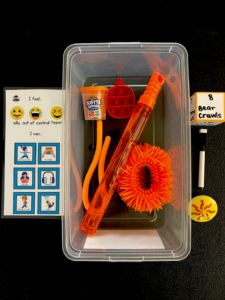
Pro-tip! If you know that your child has a hard time with sensory regulation, talk to the hair professional ahead of time and explain your situation. Hairdressers want their clients to feel comfortable, so by giving the hairdresser a heads up about your kiddo’s needs, they are likely to help brainstorm solutions (i.e., private room vs being in the main area, comfy chair vs. salon chair, scissors vs. clippers, etc.) There are several hairdressers in our local community that are familiar with providing haircuts to children with sensory needs and have experience working with children with autism spectrum disorder. Some of my favorite places to recommend to parents of students with autism spectrum disorder in Southern Delaware are: Bad Hair Day, Bling, R. Sterling, Salon on Savannah, and Olive and Jules. Lastly, if the setting and location plays a large factor, some hairdressers are even open to coming to your home to cut your child’s hair to help reduce environmental stressors. Overall, your goal is to help your child learn that getting a haircut is a fun, positive, and safe experience!
Want to learn more tips and tricks? Check out the handout created for Tools for Tots at the Lewes Public Library on April 16th, 2024. Kids and families participated in a fun workshop, “Wash, Trim, Buzz”: Preparing Kids for Trips to the Barber or Stylist. During Tools for Tots workshops, caregivers learn healthy, developmentally-appropriate tips and strategies to help little ones embark positively into community experiences “Around Town”. Child Inspired’s pediatric specialists provided positive tips and strategies for “barber shop play” at home and experiences with stylists. And kids explored playful activities and prepared a fun, personalized mirror as a make-and-take to bring along to their next haircut.
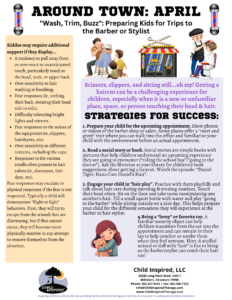
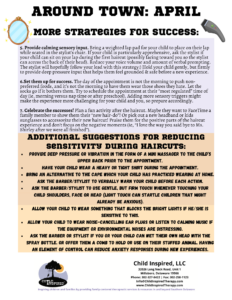
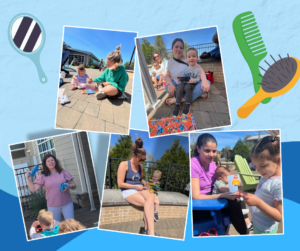
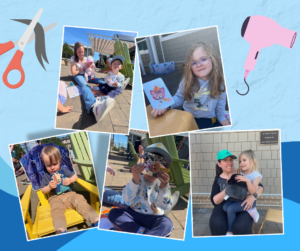
Authored by Lexi Gooch, Family Education Specialist
Child Inspired is a family-centered, pediatric therapy practice in Southern Delaware . We are so proud of the inspiring group of pediatric therapists and educators that are working collaboratively to bring help and healing to children and families with in-home, outpatient therapy services and community outreach initiatives. The Child Inspired team takes their work very seriously, but does make sure to sprinkle in moments of silliness and laughter, as we all need strategies to cope with the various challenges we must navigate.
Thanks for being part of our community! We’d love to hear from you!

